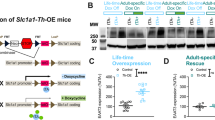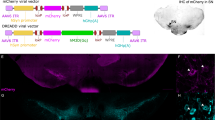Abstract
The tic disorder Tourette's Syndrome (TS) and obsessive-compulsive disorder (OCD) are comorbid behavioral disorders, suggesting a shared but still unknown neuronal basis. To ‘circuit-test’ such behaviors, we previously engineered transgenic mice expressing a neuropotentiating protein (cholera toxin A1 subunit) within a cortical-limbic subset of dopamine D1-receptor expressing (D1+) neurons known to trigger glutamatergic excitation of orbitofrontal, sensorimotor, limbic and efferent striatal circuits thought to be hyperactive or affected in OCD and TS. These mice exhibited OCD-like behaviors including generalized behavioral perseveration and compulsion-like leaping and grooming-associated pulling and biting of skin and hair. We now report that these OCD-like mice, like humans, also exhibit comorbid TS-like behaviors, including juvenile-onset tics; increased tic number, complexity and flurries; increased tic severity in males; voluntary tic suppression; and tic responsiveness to a non-cataleptic TS+OCD drug therapy (clonidine, 0.01 mg kg−1). These data suggest that hormonal gender differences, apart from the influence of genetic or autoimmune etiologic factors, may be sufficient to aggravate tic severity in human TS males compared to TS females. These data also proffer a precise neuronal basis for TS+OCD, wherein tics and primary compulsions or obsessions are evoked by hyperactivity of various cortical-limbic projection neurons’ glutamatergic output to efferent targets like the striatum. The ‘Cortical-limbic Glutamatergic Neuron’ (CGN) neuronal circuit model merges formerly opposed neurotransmitter models of TS and OCD, and is consistent with new clinical reports of increased cortical hyperactivity, striatal glutamate and striatal inhibitory D2 receptors, and reduced striatal responsiveness, in these disorders.
This is a preview of subscription content, access via your institution
Access options
Subscribe to this journal
Receive 12 print issues and online access
$259.00 per year
only $21.58 per issue
Buy this article
- Purchase on Springer Link
- Instant access to full article PDF
Prices may be subject to local taxes which are calculated during checkout





Similar content being viewed by others
References
Pauls DL, Leckman JF . The inheritance of Gilles de la Tourette's syndrome and associated behaviors. Evidence for autosomal dominant transmission N Engl J Med 1986 315: 993–997
Singer HS, Walkup JT . Tourette syndrome and other tic disorders. Diagnosis, pathophysiology, and treatment Medicine (Baltimore) 1991 70: 15–32
Garvey MA, Giedd J, Swedo SE . PANDAS: the search for environmental triggers of pediatric neuropsychiatric disorders. Lessons from rheumatic fever J Child Neurol 1998 13: 413–923
Leonard HL, Lenane MC, Swedo SE, Rettew DC, Gershon ES, Rapoport JL . Tics and Tourette's disorder: a 2- to 7-year follow-up of 54 obsessive-compulsive children Am J Psychiatry 1992 149: 1244–1251
Frankel M, Cummings JL, Robertson MM, Trimble MR, Hill MA, Benson DF . Obsessions and compulsions in Gilles de la Tourette's syndrome Neurology 1986 36: 378–382
Van Ameringen M, Mancini C, Oakman JM, Farvolden P . The potential role of haloperidol in the treatment of trichotillomania J Affect Disord 1999 56: 219–226
The Tourette Syndrome Classification Study Group. Definitions and classification of tic disorders Arch Neurol 1993 50: 1013–1016
American Psychiatric Association. Diagnostic and Statistical Manual of Mental Disorders (DSM-IV), 4th edn American Psychiatric Press: Washington, DC 1994 p xxvii 78–105 886
Sheppard DM, Bradshaw JL, Purcell R, Pantelis C . Tourette's and comorbid syndromes: obsessive compulsive and attention deficit hyperactivity disorder A common etiology? Clin Psychol Rev 1999 19: 531–552
Kurlan R, Kersun J, Ballantine HT Jr, Caine ED . Neurosurgical treatment of severe obsessive-compulsive disorder associated with Tourette's syndrome Mov Disord 1990 5: 152–155
Swedo SE, Pietrini P, Leonard HL, Schapiro MB, Rettew DC, Goldberger EL et al. Cerebral glucose metabolism in childhood-onset obsessive-compulsive disorder. Revisualization during pharmacotherapy Arch Gen Psychiatry 1992 49: 690–694
Breiter HC, Rauch SL, Kwong KK, Baker JR, Weisskoff RM, Kennedy DN et al. Functional magnetic resonance imaging of symptom provocation in obsessive-compulsive disorder Arch Gen Psychiatry 1996 53: 595–606
Greenberg BD, Ziemann U, Cora-Locatelli G, Harmon A, Murphy DL, Keel JC et al. Altered cortical excitability in obsessive-compulsive disorder Neurology 2000 54: 142–147
Ziemann U, Paulus W, Rothenberger A . Decreased motor inhibition in Tourette's disorder: evidence from transcranial magnetic stimulation Am J Psychiatry 1997 154: 1277–1284
Rosenberg DR, MacMaster FP, Keshavan MS, Fitzgerald KD, Stewart CM, Moore GJ . Decrease in caudate glutamatergic concentrations in pediatric obsessive-compulsive disorder patients taking paroxetine J Am Acad Child Adolesc Psychiatry 2000 39: 1096–1103
Sheldon PW, Aghajanian GK . Excitatory responses to serotonin (5-HT) in neurons of the rat piriform cortex: evidence for mediation by 5-HT1C receptors in pyramidal cells and 5-HT2 receptors in interneurons Synapse 1991 9: 208–218
Jakab RL, Goldman-Rakic PS . 5-Hydroxytryptamine2A serotonin receptors in the primate cerebral cortex: possible site of action of hallucinogenic and antipsychotic drugs in pyramidal cell apical dendrites Proc Natl Acad Sci USA 1998 95: 735–740
Aghajanian GK, Marek GJ . Serotonin, via 5-HT2A receptors, increases EPSCs in layer V pyramidal cells of prefrontal cortex by an asynchronous mode of glutamate release Brain Res 1999 825: 161–171
Cohen DJ, Riddle MA, Leckman JF . Pharmacotherapy of Tourette's syndrome and associated disorders Psychiatr Clin North Am 1992 15: 109–129
Campbell KM, de Lecea L, Severynse DM, Caron MG, McGrath MJ, Sparber SB et al. OCD-Like behaviors caused by a neuropotentiating transgene targeted to cortical and limbic D1+ neurons J Neurosci 1999 19: 5044–5053
Burton FH, Hasel KW, Bloom FE, Sutcliffe JG . Pituitary hyperplasia and gigantism in mice caused by a cholera toxin transgene Nature 1991 350: 74–77
Wright DE, Seroogy KB, Lundgren KH, Davis BM, Jennes L . Comparative localization of serotonin1A, 1C, and 2 receptor subtype mRNAs in rat brain J Comp Neurol 1995 351: 357–373
Campbell KM, McGrath MJ, Burton FH . Behavioral effects of cocaine on a transgenic mouse model of cortical-limbic compulsion Brain Res 1999 833: 216–224
McGrath MJ, Campbell KM, Veldman MB, Burton FH . Anxiety in a transgenic mouse model of cortical-limbic neuropotentiated compulsive behavior Behav Pharmacol 1999 10: 435–443
McGrath MJ, Campbell KM, Burton FH . The role of cognitive and affective processing in a transgenic mouse model of cortical-limbic neuropotentiated compulsive behavior Behav Neurosci 1999 113: 1249–1256
Alexander GE, DeLong MR, Strick PL . Parallel organization of functionally segregated circuits linking basal ganglia and cortex Annu Rev Neurosci 1986 9: 357–381
Cohen DJ, Shaywitz BA, Caparulo B, Young JG, Bowers MB Jr . Chronic, multiple tics of Gilles de la Tourette's disease. CSF acid monoamine metabolites after probenecid administration Arch Gen Psychiatry 1978 35: 245–250
Hollander E, Fay M, Cohen B, Campeas R, Gorman JM, Liebowitz MR . Serotonergic and noradrenergic sensitivity in obsessive-compulsive disorder: behavioral findings Am J Psychiatry 1988 145: 1015–1017
Wolf SS, Jones DW, Knable MB, Gorey JG, Lee KS, Hyde TM et al. Tourette syndrome: prediction of phenotypic variation in monozygotic twins by caudate nucleus D2 receptor binding Science 1996 273: 1225–1227
Peterson BS, Skudlarski P, Anderson AW, Zhang H, Gatenby JC, Lacadie CM et al. A functional magnetic resonance imaging study of tic suppression in Tourette syndrome Arch Gen Psychiatry 1998 55: 326–333
Matsumoto K, Mizowaki M, Thongpraditchote S, Murakami Y, Watanabe H . alpha2-Adrenoceptor antagonists reverse the 5-HT2 receptor antagonist suppression of head-twitch behavior in mice Pharmacol Biochem Behav 1997 56: 417–422
Campbell KM, McGrath MJ, Burton FH . Differential response of cortical-limbic neuropotentiated compulsive mice to dopamine D1 and D2 receptor antagonists Eur J Pharmacol 1999 371: 103–111
Cohen DJ, Leckman JF, Pauls D . Neuropsychiatric disorders of childhood: Tourette's syndrome as a model Acta Paediatr Suppl 1997 422: 106–111
Swedo SE, Leonard HL, Mittleman BB, Allen AJ, Rapoport JL, Dow SP et al. Identification of children with pediatric autoimmune neuropsychiatric disorders associated with streptococcal infections by a marker associated with rheumatic fever Am J Psychiatry 1997 154: 110–112
Peterson BS, Leckman JF, Scahill L, Naftolin F, Keefe D, Charest NJ et al. Steroid hormones and CNS sexual dimorphisms modulate symptom expression in Tourette's syndrome Psychoneuroendocrinology 1992 17: 553–563
Lichter DG, Jackson LA . Predictors of clonidine response in Tourette syndrome: implications and inferences J Child Neurol 1996 11: 93–97
Campbell KM, Veldman MB, McGrath MJ, Burton FH . TS+OCD-like neuropotentiated mice are supersensitive to seizure induction NeuroReport 2000 11: 2335–2338
McGrath MJ, Parks CRI, Burton FH . Glutamatergic drugs exacerbate symptomatic behavior in a transgenic model of comorbid Tourette's Syndrome and obsessive-compulsive disorder Brain Res 2000 877: 23–30
Edgley SA, Lemon RN . Experiments using transcranial magnetic brain stimulation in man could reveal important new mechanisms in motor control J Physiol (Lond) 1999 521: 565
Robertson MM, Schnieden V, Lees AJ . Management of Gilles de la Tourette syndrome using sulpiride Clin Neuropharmacol 1990 13: 229–235
Ceccherini-Nelli A, Guazzelli M . Treatment of refractory OCD with the dopamine agonist bromocriptine J Clin Psychiatry 1994 55: 415–416
Gilbert DL, Sethuraman G, Sine L, Peters S, Sallee FR . Tourette's syndrome improvement with pergolide in a randomized, double-blind, crossover trial Neurology 2000 54: 1310–1315
Bonnier C, Nassogne MC, Evrard P . Ketanserin treatment of Tourette's syndrome in children Am J Psychiatry 1999 156: 1122–1123
Cromwell HC, Berridge KC, Drago J, Levine MS . Action sequencing is impaired in D1A-deficient mutant mice Eur J Neurosci 1998 10: 2426–2432
Castellanos FX, Giedd JN, Elia J, Marsh WL, Ritchie GF, Hamburger SD et al. Controlled stimulant treatment of ADHD and comorbid Tourette's syndrome: effects of stimulant and dose J Am Acad Child Adolesc Psychiatry 1997 36: 589–596
Kratochvil CJ, Bohac D, Harrington M, Baker N, May D, Burke WJ . An open-label trial of tomoxetine in pediatric attention deficit hyperactivity disorder J Child Adolesc Psychopharmacol 2001 11: 167–170
Michelson D, Faries D, Wernicke J, Kelsey D, Kendrick K, Sallee FR et al. Atomoxetine in the treatment of children and adolescents with attention-deficit/hyperactivity disorder: a randomized, placebo-controlled, dose-response study Pediatrics 2001 108: E83
Carlsson ML . On the role of cortical glutamate in obsessive-compulsive disorder and attention-deficit hyperactivity disorder, two phenomenologically antithetical conditions Acta Psychiatr Scand 2000 102: 401–413
Acknowledgements
This work was supported by the TSA and NARSAD.
Author information
Authors and Affiliations
Corresponding author
Rights and permissions
About this article
Cite this article
Nordstrom, E., Burton, F. A transgenic model of comorbid Tourette's syndrome and obsessive-compulsive disorder circuitry. Mol Psychiatry 7, 617–625 (2002). https://doi.org/10.1038/sj.mp.4001144
Received:
Revised:
Accepted:
Published:
Issue Date:
DOI: https://doi.org/10.1038/sj.mp.4001144
Keywords
This article is cited by
-
The Sapap3−/− mouse reconsidered as a comorbid model expressing a spectrum of pathological repetitive behaviours
Translational Psychiatry (2023)
-
A prospective clinical cohort-based study of the prevalence of OCD, obsessive compulsive and related disorders, and tics in families of patients with OCD
BMC Psychiatry (2022)
-
Behavioral and synaptic alterations relevant to obsessive-compulsive disorder in mice with increased EAAT3 expression
Neuropsychopharmacology (2019)
-
Neurochemical and behavioral characterization of neuronal glutamate transporter EAAT3 heterozygous mice
Biological Research (2017)
-
Allopregnanolone mediates the exacerbation of Tourette-like responses by acute stress in mouse models
Scientific Reports (2017)



